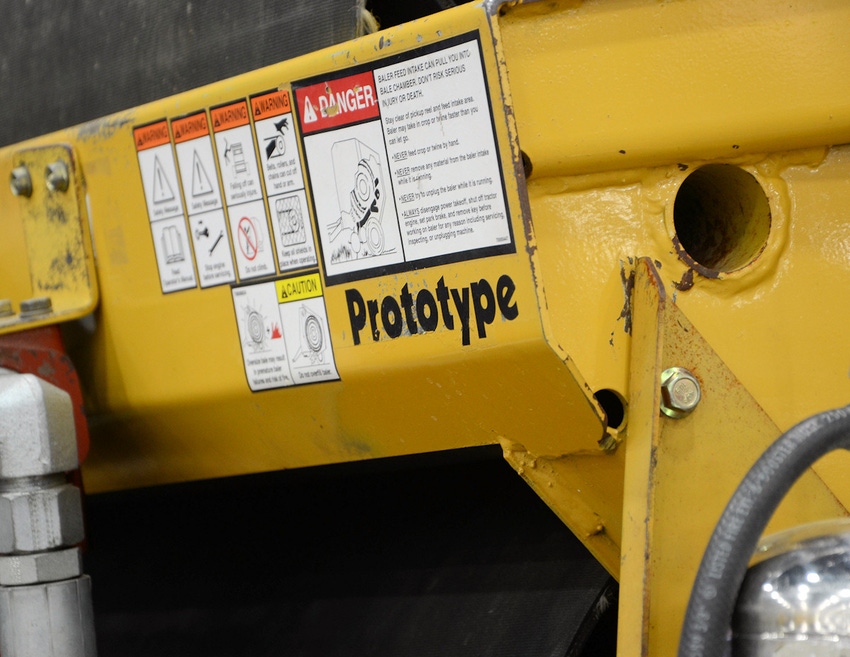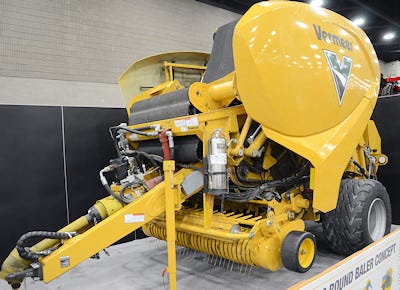February 17, 2016

During the National Farm Machinery Show we caught up with Vermeer to check out their working prototype of the Continuous Round Baler. Journalists got their first sneak peek at the machine two years ago, and work continues on its development. There's some news - see the five points for what's new for 2016 below - and we thought a quick refresher was a good idea for readers.
1. No timeframe set for its debut, yet.
Farmers have been interested in this baler since news broke. Jessica Reis, brand manager, forage solutions, explains that farmers do ask when it's coming to market, but that's not the first question they ask. "First they ask how much it costs," she smiles. That detail isn't available yet, but this won't be the price of a standard baler since in fact it's two balers in one.
2. This round baler needs more horsepower to run
During our conversation at the National Farm Machinery Show we revisited the horsepower requirement for this machine. It will require at least 165 PTO horsepower to run, but Reis notes that for most larger producers who are the likely target customer this won't be a problem. Many already have bigger tractors for other farm work, and custom hay-makers are running bigger equipment too.
3. User interface is still under-development, and ISO compliance is a must
Vermeer engineers and employees are running this machine now as it gets further refined. The key development area going forward will be the user interface, as Ty Hartwick, who is the chief engineer on the project, explains. Hartwick notes that users will find they can make more hay in a day and take advantage of the best weather to put up more hay.

Vermeer had a prototype baler on the show floor at the National Farm Machinery Show - behind a fence - but visitors got a good look at the machine. First question: What does it cost? Second question: When will it be available?
Vermeer had a prototype baler on the show floor at the National Farm Machinery Show - behind a fence - but visitors got a good look at the machine. First question: What does it cost? Second question: When will it be available?Another key area of development is user safety. This machine has a lot of moving parts and now engineers have to make sure all the safety systems are in place. Hartwick also notes that the baler will be ISO compatible to work with most controllers on the market.
4. Running plenty of bales through the prototypes
The key reason Vermeer "went public" in 2014 with this baler is that they're running the machine in different parts of the country. The machine you see in this report was brought in from the field - and barely cleaned up. Reis notes that at any given time there's a prototype running somewhere that a baler can make hay. Remember that marketing partner Lely is also developing its own version of the baler and also brought the machine to Agritechnica with hay and dirt part of the package.
Check out the pictures with this story and note this is not a shiny new baler. As for prototypes running, the company has put more than 18,000 bales through its U.S. prototypes since field development work began. The crops baled so far include alfalfa, rye grass, bahia grass, orchard grass, sudan-grass, hermathia, clover, fescue, star grass, oats and cornstalks.
5. Putting real farmers in the seat
This summer Vermeer will be putting more than employees into the tractor seat to run this new baler. "We're working to have some customers run the prototypes this year," Reis says. These will be the first non-Vermeer employees to get some seat time with the machine and see how it operates in the field. It's another important step to bringing this new non-stop round baler to market.
About the Author(s)
You May Also Like






